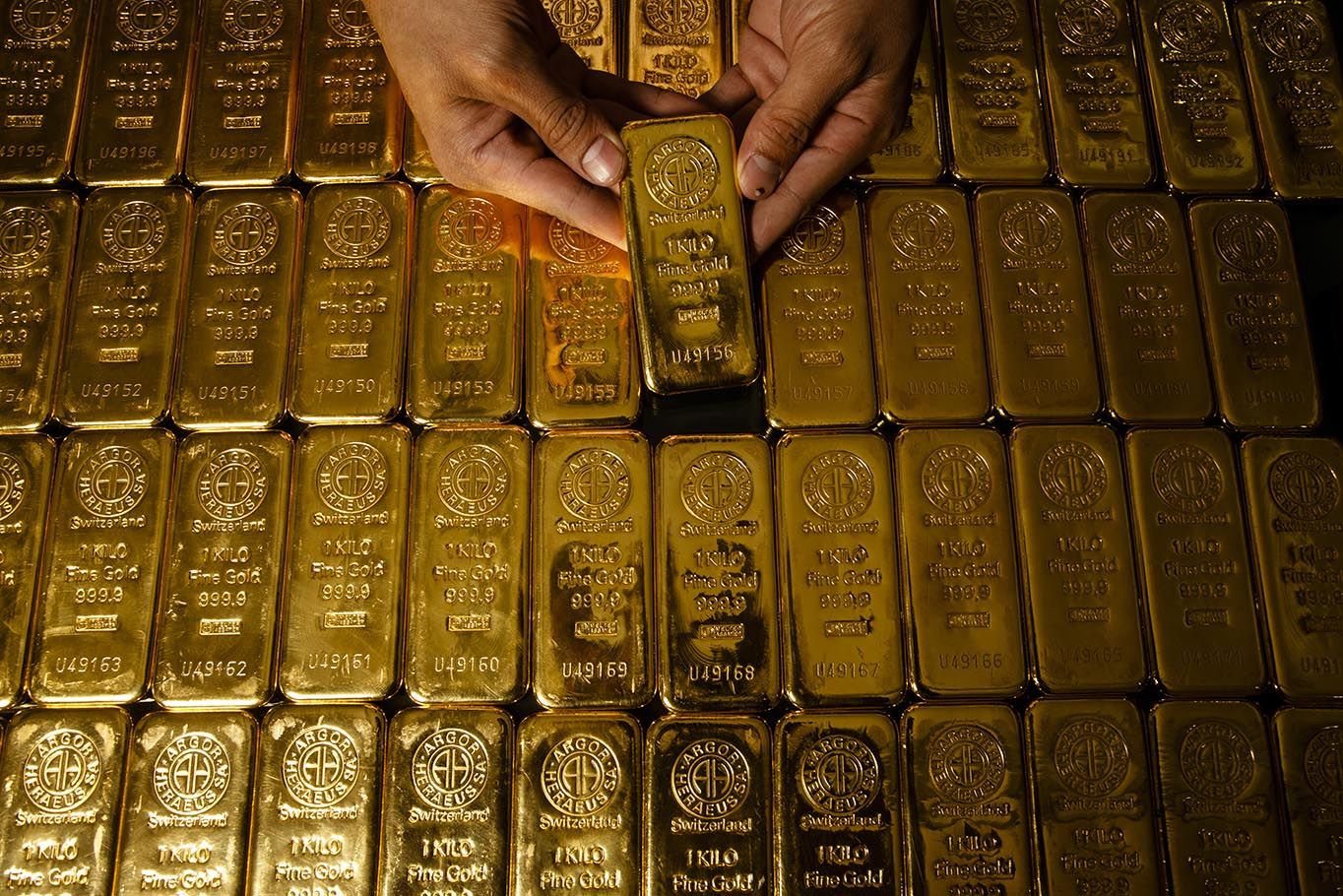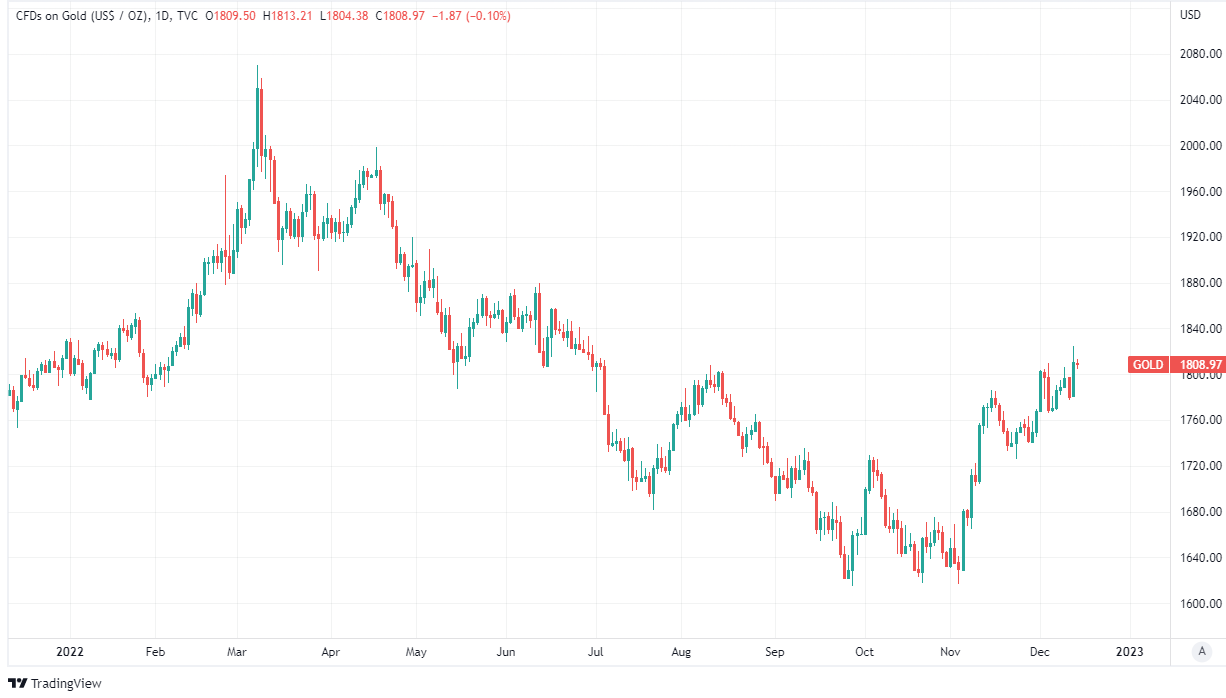Gold Price Set to Shine Brighter in Year Ahead as U.S. Dollar Ebbs
- Written by: James Skinner
-
"Until the end of the Fed’s rate hike cycle is complete, and institutional demand for gold increases, prices may be constrained" - HSBC.

The gold price changed little in 2022 but with the U.S. Dollar showing signs of rolling over of late it could get an opportunity to shine brighter in the year ahead.
Gold had appeared poised to rise significantly alongside energy and food commodities after the Russian military crossed into Ukraine back in February but the metal's rally didn't last for long and since then it has underperformed other commodities as well as the market's better performing currencies.
But recent inflation figures from the U.S. have partially reversed this year's strong rally by the Dollar and since then gold has reached six-month highs.
"Historically, USD levels have exerted a significant influence on gold, and normally gold trades inversely with the USD. USD strength, which reached levels not seen in decades, played a key role in gold weakness for most of 2022," says James Steel, chief precious metal strategist at HSBC.
"The apparent change in the USD’s fortunes – which is occurring a little earlier than we had anticipated – set off the recent gold rally and alters the timing for further likely gold gains in 2023," Steel adds while writing in summary of HSBC's year ahead forecasts this week.

While the economic risks posed by the invasion of Ukraine appeared set to lift gold back above the $2,000 per ounce level seen in 2020, the Federal Reserve (Fed) interest rate response to sharply accelerating inflation and its effect on the Dollar was quick to dampen prices.
"Although some easing in inflation pressures have called the pace of Fed rate increases going forward into question, recent comments from Fed officials confirm further tightening. Fed tightening could remain an important negative for gold at least into Q1 2023," Steel cautions.
"Until the end of the Fed’s rate hike cycle is complete, and institutional demand for gold increases, prices may be constrained. This leads us to look for weakish prices in early 2023 with increases more likely as the year unfolds," he adds.
Many around the market now see U.S. interest rates as likely to peak early next year and this week's inflation data may have made that more likely, implying a possibly more supportive environment for gold in the year ahead.
HSBC had forecast the gold price would end next year around $1,701 per ounce but lifted that projection to $1,813 per ounce earlier in December.
HSBC's forecast was reached briefly already on Tuesday this week, though its projections are modest when compared with those of Goldman Sachs.
The difference between the two sets of forecasts is in their expectations of demand for precious metals among exchange-traded-funds (ETFs), jewellers and emerging market central banks following what many believe was a record quarter of demand from monetary authorities in some parts of the world.
"Even without any further gold purchases in Q4, 2022 is set to be a record year for CB [central bank] gold demand," says Mikhail Sprogis, a metals strategist in the Global Investment Research Commodities team at Goldman Sachs.
"We believe that structurally higher EM CB demand creates an asymmetric payoff for gold as it provides a floor to gold if further ETF liquidation occurs in response to further hawkish Fed surprises," he adds.
World Gold Council estimates suggest central bank demand reached a record last quarter while the Goldman Sachs team suspects this has to do with geopolitics and a need for a "politically neutral store of value."
"In a scenario where a US recession leads to a turn in the US monetary cycle, we estimate that gold could rally by 20-30% depending on the degree of the cuts. We therefore remain constructive on gold with unchanged 3/6/12m price targets of $1,850/1,950/1,950/toz," he adds.
Reports of rising central bank demand follow this year's decision by G7 countries and the European Union to freeze Russian central bank reserves held in the most liquid of major economy currencies.
However, with the gold price having risen during five of the last seven periods of recession in the global economy, there are also other factors that could aid an improved performance from the metal in the year ahead.
"Consensus forecasts now expect global GDP to rise by just 2.1% next year. 4 Excluding the global financial crisis and COVID, this would mark the slowest pace of global growth in four decades and meet the IMF’s previous definition of a global recession," the World Gold Council says.
"But a recession is not a prerequisite for gold to perform. A sharp retrenchment in growth is sufficient for gold to do well, particularly if inflation is also high or rising," it adds in a December contemplation of the year ahead.
